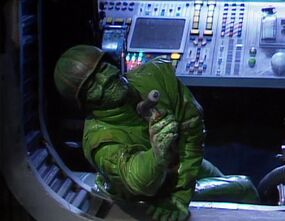Chimeron: Difference between revisions
m (thumbnails need to have their widths undefined so that users preference settings for thumbnails will work) |
m (upholding T:HUMAN) |
||
| Line 8: | Line 8: | ||
|appearances = [[DW]]: ''[[Delta and the Bannermen]]'' | |appearances = [[DW]]: ''[[Delta and the Bannermen]]'' | ||
|mentions= | |mentions= | ||
|individuals = <ul><li>[[Delta]]</li><li>[[Billy (Delta and the Bannermen)|Billy]] (former [[ | |individuals = <ul><li>[[Delta]]</li><li>[[Billy (Delta and the Bannermen)|Billy]] (former [[human]])</li><li>[[Chimeron Princess]]</li></ul> | ||
}} | }} | ||
The '''Chimeron''' (pronounced shimmer-on) were a race of insect-behaviored [[humanoid]]s who were nearly made extinct by the [[Bannermen]]. | The '''Chimeron''' (pronounced shimmer-on) were a race of insect-behaviored [[humanoid]]s who were nearly made extinct by the [[Bannermen]]. | ||
Revision as of 00:30, 20 October 2011
The Chimeron (pronounced shimmer-on) were a race of insect-behaviored humanoids who were nearly made extinct by the Bannermen.
They were native to the planet Chumeria, commonly known as "the garden planet of the universe". Chimerons showed vast differences in appearance between genders and went through a complex road to maturity.
Biology
Life cycle
Chimerons hatched from large grey eggs on a brood planet and started as green, wrinkly infants. Though males kept this appearance throughout their life, the queens of the species had a slightly different development.
In order to properly develop, young queens were fed Chimeron jelly until they were fully grown. Their coming into adulthood was marked by the Singing time.
In the first few hours after birth, Chimerons rapidly grew and became more human looking, developing hair and other more distinct facial features and began to lose their wrinkles.
Adult queen Chimerons looked similar to human females with slightly green skin and grey patches behind the ears. (DW: Delta and the Bannermen)
Abilities
Chimeron queens also developed a strong singing voice, partly as communication and partly as a powerful means of defence.
Once they reached the Singing Time, they perfected their defensive songs and grew to almost adult size. Adult queens could detect high frequencies with the grey patches behind their ears. (DW: Delta and the Bannermen)
Technology
Chimerons had high level weaponry and spaceships. A portable incubator housed a Chimeron egg until it hatched.
Chimeron produced Chimeron jelly, though whether this was a natural or manufactured item is unknown. The jelly was capable of converting other species (humans, at least) into Chimerons. The side effects of this process were unknown. (DW: Delta and the Bannermen)
History
The Chimerons were nearly wiped out by the Bannermen, but the last queen, Delta, was able to escape with an egg. The egg hatched on Earth, and with the assistance of the Seventh Doctor, Delta and her daughter were able to escape annihilation by the Bannermen.
They left Earth along with Billy, a human whom Delta had fallen in love with. He took some Chimeron Jelly to become a Chimeron; without him the species could not continue. (DW: Delta and the Bannermen)
Behind the scenes
- The script of Delta describes them as "soft [and] puma-like" and notes that they resemble "puffy Michelin Men in iridescent green suits, segmented like insects, silvery green skin. Their hair is silver and they have startling blue eyes." (INFO: Delta and the Bannermen)
| ||||||||||||||



